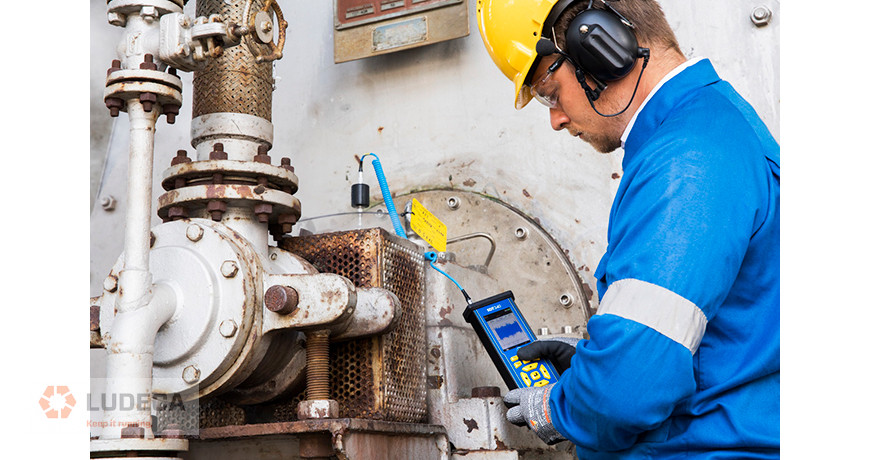
Ultrasound is an especially good tool for detecting bearing problems on slow-speed machines. However, there are some common misconceptions about how this is accomplished. The rules behind the processing of the acquired signal are the same for ultrasound or vibration analysis.
A rolling element bearing’s Fundamental Train Frequency (FTF) or Cage Frequency is usually somewhere around 30% to 40% of the shaft turning frequency. This means that the shaft must rotate three or four revolutions before the cage has made one complete revolution. To correctly identify the bearing’s cage frequency, data should be collected during ten to twelve revolutions of the shaft, and in slow speed applications, this sometimes requires that the user set up the data collector properly to record for several minutes.
Analyzing vibration data collected on slow speed machines becomes difficult because they typically generate small amounts of centrifugal force. Accelerometers are designed to measure force and because of this detecting small bearing defect frequencies hidden in the noise floor becomes very challenging. Low levels of centrifugal force coupled with low level amplitudes coming from the bearing defect frequencies make identifying Stage 1 defects extremely difficult.
The good news is that ultrasonic sensors do not have this problem! Ultrasonic contact sensors measure the sound levels coming from the bearing and have been used successfully to detect bearing defects on machines operating as slowly as 1 rpm!
by Diana Pereda
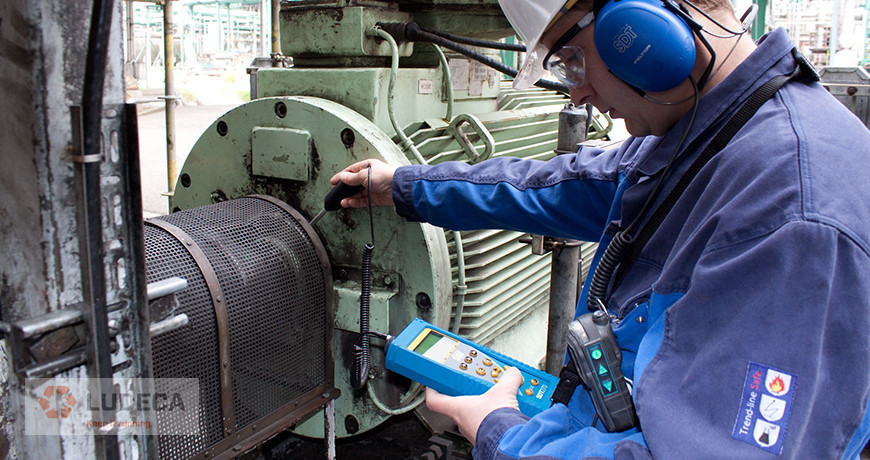
Damage inside of a rolling element bearing begins with sub-surface fatigue and results in a detectable sound signal that occurs in the ultrasonic frequency range. Ultrasound can be used to detect these Stage 1 bearing defects which would not be visible looking at typical vibration spectrum. If you listen to the sound that is being produced from a bearing with a Stage 1 defect, it would sound relatively smooth and sound similar to a bearing that was in need of lubrication. The difference between the two is that after adding lubricant to the bearing with the Stage 1 defect, the amplitude of the sound would not decrease, whereas with a bearing requiring lubrication the sound level should reduce and return to baseline.
As the wear progresses and the sub-surface cracks become larger, eventually this damage enters Stage 2 and the cracks become a spall. The sound of each rolling element passing over a spall on the outer race of the bearing is easy to hear, and since the spacing of the rolling elements is consistent, the sound produced is consistent and repetitive.
Ultrasound is an especially good tool for detecting bearing problems on slow-speed machines. However, there are some common misconceptions about this and how it is done. Just because you are using ultrasound over a conventional vibration analysis setup does not change the rules of signal processing.
The same rules still apply using both.
The cage frequency or fundamental train frequency (FTF) for most rolling element bearings is usually somewhere around 30% – 40% of the turning shaft frequency. That means that the shaft must rotate three or four times before the cage has made one revolution. To be able to resolve the cage frequency at least ten to twelve revolutions of the shaft are required, and in slow speed applications this might require the user to collect data for several minutes in order to determine the health of the bearing’s cage.
Another consideration in monitoring slow speed machines is that because of their slow speeds they generate low amounts of centrifugal force and vibration sensors are designed to measure force. Thus, the low levels of centrifugal force coupled with low amplitude signals coming from the Stage 1 defect make it difficult for vibration sensors to easily identify Stage 1 bearing defects.
The ultrasonic sensor on the other hand doesn’t have this problem because it’s not designed to measure centrifugal force. The ultrasound sensor only measures the sound levels in within the bearing assembly and has been used successfully to detect bearing defects on machines operating as slowly as 1 rpm.
Download our 4 Stages Bearing Failures infographic for a basic reference guide to understanding the stages of bearing failures. Perfect to hang at your facility too!
by Diana Pereda
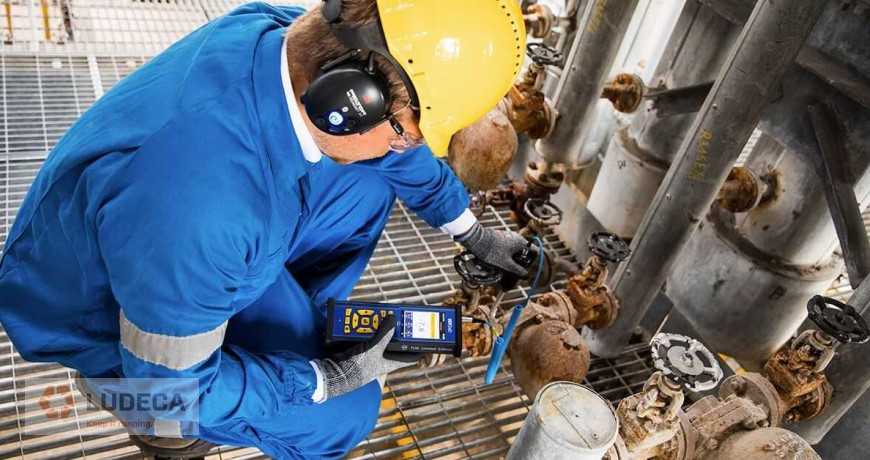
What is the proper technique for performing steam trap inspections? My short answer never changes. It involves two readings…one was taken a few feet upstream of the steam trap to ensure there is flow, and the other reading was taken immediately after the steam trap. If the steam trap is operating correctly, you will hear it cycle. Ultrasonically, this means the signal downstream of the steam trap should be silent, followed by intermittent increases in dBµV levels, indicating a discharge.
By listening to a steam trap cycle this way, ultrasound technicians can determine if the steam trap is cycling properly and functioning as it should. Technicians will also be able to determine any linkage issues the steam trap may be facing.
Over the years, I have found issues with this inspection method. The most glaring issue is that steam traps vary widely in cycle times. This leads to inconsistent and unpredictable inspection times. While this is more of a nuisance than anything else, it still makes inspectors think twice about performing inspections and predictive maintenance interventions on steam traps – especially when considering most steam traps can be replaced for a few hundred dollars.
What Do Unmaintained Steam Traps Cost You?
Is it a waste of time, money, and resources performing condition monitoring and implementing predictive maintenance interventions on an asset with such a low replacement cost?
No! It is not a waste of time, money, or resources. Your steam system and the steam traps that comprise them are designed to deliver clean steam from the boiler rooms to the intended point of use as efficiently as possible. And steam is not a cheap industrial resource to create.
The heat energy required to convert water to steam is measured in British Thermal Units. One BTU raises the temperature of one pound of water, by one degree Fahrenheit. This means when a pound of the steam condenses back to the water, one BTU was wasted.
Your steam system should minimize steam loss, maximize the transfer of heat, and remove condensable and non-condensable gasses that make your steam impure. When the assets that make up your steam system are ignored, your steam systems components degrade, your steam systems efficiency deteriorates, and eventually, your steam system won’t be able to deliver on its engineered purpose.
Failures in your steam system result in lost steam through leaks and lost steam when it condenses back to water vapor, and lesser quality steam reaches its intended point of use. Failures in your steam system also mean more greenhouse emissions as a result of having to produce more steam to compensate for losses. The bottom line, poorly maintained steam systems result in more losses than that just the price of replacing parts.
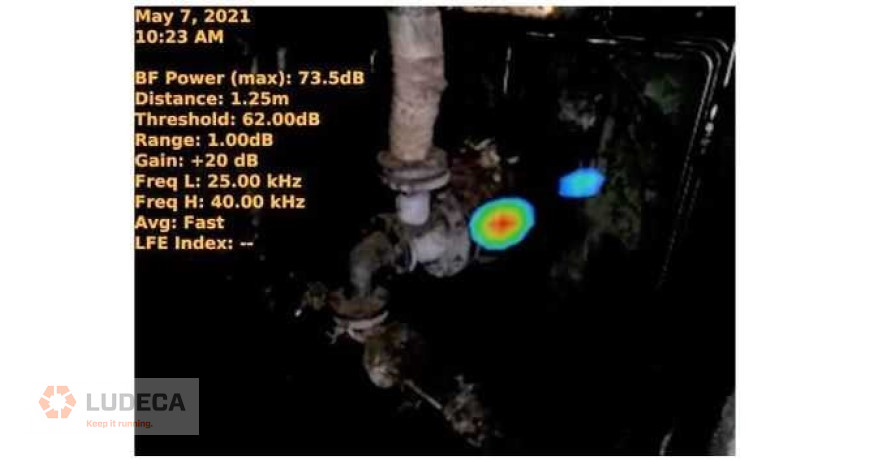
Safely Inspecting Steam Traps
Before going further, I would first like to point out that steam is a dangerous commodity. Maintenance personnel, factory workers, and condition monitoring technicians need to be aware that steam has both pressure and temperature, not to mention it’s also invisible. When you see what most people call “steam,” it’s actually just water vapor that has cooled down and condensed back to water – and it’s not overly dangerous.
On the other hand, invisible steam leaks are very hot, very dangerous, very high pressure, and very INVISIBLE. They can burn through clothes and melt human flesh. This is why I always strongly recommend technicians go out to monitor steam traps and wear the proper PPE. That means wearing long sleeves, gloves, eye protection, and any other articles of PPE that are mandated for that location of your facility.
Before I enter an area where there might be live steam leaks, I like to perform an airborne ultrasonic inspection of the area. The best tool for this is the SonaVu™ Acoustic Imaging Camera, as it not only locates steam leaks in your steam system but also visualizes any potential danger on screen.
After performing an airborne ultrasound inspection and confirming there are no dangerous steam leaks, I can proceed with my contact ultrasound inspection on the steam traps I intend to monitor.
Click here to continue reading the entire article, “Best Practices for Inspecting Steam Traps” and learn about the remaining three best practices so you can properly inspect steam traps!
Related Blog: What are SDT Ultrasound Solutions Four Condition Indicators?
by Diana Pereda
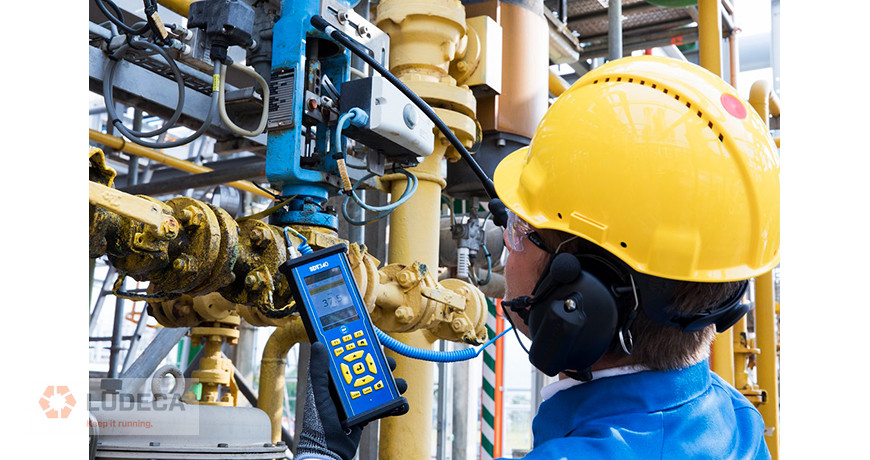
Obviously, getting leakage repaired after the detection effort is done is extremely challenging and sometimes frustrating in today’s economy. But, where many plants fail, others do extremely well in managing their leakage levels. The latter plants are the ones using best practices.
In conducting leak assessments four important steps come up when researching the practices of the best-performing industrial plants. These are:
- Baseline and monitor: The best plants keep track of their leaks with flow meters and are able to identify where they are at and how much they have saved each time they do their leakage assessments.
- Proper tools for the job: Top-performing plants have an excellent set of ultrasonic detection tools at their disposal, with available staff trained on the use of the devices. There is a wide range of available leak detectors out on the market, from basic small-budget units costing less than $500 to top-of-the-line units costing over $10,000. For compressed air leakage auditing, it is usually best to use simplified leak detectors of mid-range cost. Very complex detectors designed for other ultrasonic work are often so complex they defend themselves from use, therefore staff rarely want to place these into service.
- Detect, document, and fix: Best-practice plants have a simple set of procedures in place where leaks are detected and tagged with brightly colored identification. The leaks are all documented and recorded in a database with accompanying photographs so the location can be easily found again and the required parts for repair procured. Staff is all trained on the cost of leakage and the use of leakage detection equipment. The database will provide an ongoing record of the trouble locations and the financial savings, which is available for staff and management. In all cases, a successful program requires someone to take responsibility for the follow-up of the leakage repair.
- Verification: Excellent leakage reduction programs ensure the results of the leakage repair is captured by some sort of easy-to-use monitoring system, with real savings calculated. This can go a long way in proving to management the benefits of spending the staff time repairing the leaks. The monitoring systems can also serve as a catalyst to further efforts. If the plant leakage level is regularly monitored, and a significant change is detected, emergency detection and repair efforts can be initiated.
Click here to continue reading the entire article, “Protect Profits with Compressed Air Leakage Best Practices”, to learn more about compressed air leaks and how ultrasound can help!
Thank you Ron Marshall with Marshall Compressed Air Consulting for this informative article!
Related Blog: 7 Compelling Reasons to Tighten your Compressed Air System
by Diana Pereda
The following is a dialogue that Paul Klimuc with SDT Ultrasound Solutions had with his students during the fourth Live Online Level One Ultrasound Certification Course.
Question: Should Compressed Air Leak Inspections be Performed During Planned Outages?
I am often asked about compressed air leak inspections… how often should compressed air leak inspections be carried out, should they occur during planned outages or regular operation hours, should the whole plant be inspected at once or should it be broken up into smaller more manageable sections.
Here are my recommendations for carrying out a successful compressed air leak inspection:
- Safety
- Frequency of Inspection
- Knowledge of the Network
- Update Plans
- Plan the Inspection
- Choosing your Equipment
- Data management
- Celebrating Wins
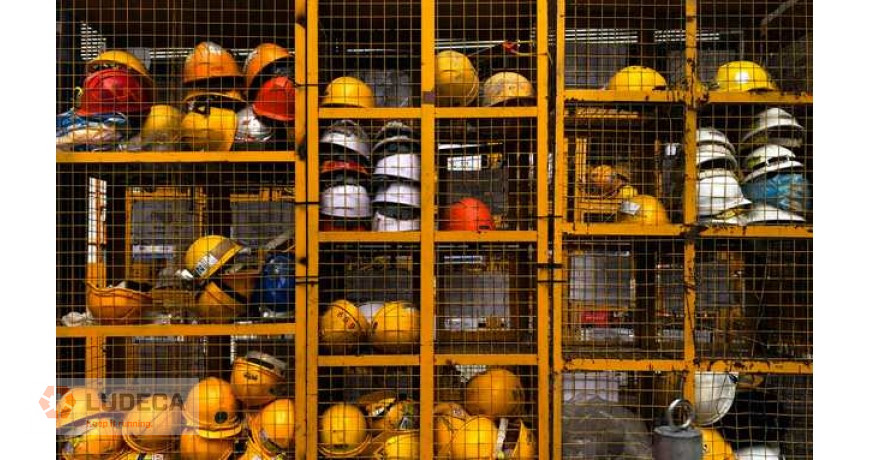
1. Safety
Safety is everyone’s number one job. Which is why I open every one of my LOLO Courses with the Poll Question, which profession suffers more casualties every year in the United States: Maintenance Workers or Firefighters? The answer is surprising to some. Even when performing a task as straightforward and “safe” as performing a compressed air leak survey, it is important to wear the correct PPE, earplugs, safety glasses, etc. And always remain aware of your surroundings. Download our Find-and-Fix Leaks with Ultrasonic Imaging procedure to survey your systems and detect compressed air, gas, and steam leaks with ultrasonic imaging.

2. Frequency of Inspection
Leak inspections are not a one-and-done task. They must be performed periodically, and it’s best if they’re broken up by dividing the plant into smaller more manageable sections and performing surveys individually (More on that later).
According to the Department of Energy, compressed air systems that have been more than a year without inspection and maintenance are likely to lose upwards of 35% of their compressed air to leaks.
So, when is the best time to perform compressed air leak surveys and inspections? During planned outages and shutdowns? No.
Ultrasound can be used effectively in extremely loud environments. The background roar of a production facility doesn’t impede its ability to locate the hissing produced by compressed air leaks. Also, if assets aren’t in operation, automated valves that close when production is down would affect compressed air supply throughout the facility, rendering the results of an air leak survey inaccurate.
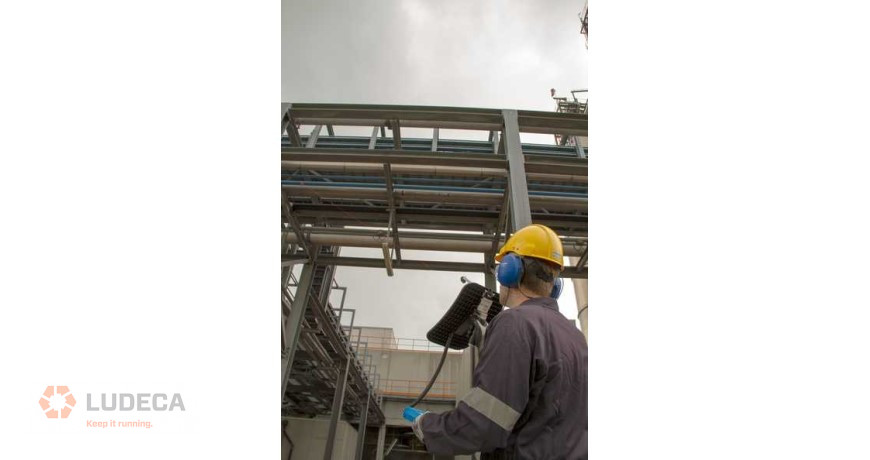
3. Knowledge of the Network
Knowing the network will improve the speed and efficiency of compressed air leak surveys, while also familiarizing the inspector with potential safety hazards.
The best way to get to know your compressed air network is to walk the inspection route prior. In a perfect world, you will be able to get your hands on schematics that illustrate piping locations, and the route the compressed air flows.
Before beginning your ultrasonic inspection, you should have an idea of what type of challenges you will face, and which sensors you will want to use during your inspection.
Click here to continue reading the entire article, “Best Practices for Performing a Compressed Air Leak Survey” to learn about Paul Klimuc’s recommendations for carrying out a successful compressed air leak inspection!
Related Blog: Ever wondered why we don’t find compressed air leaks? Here’s why!
by Diana Pereda
John Garrison is a SDT Level One Trained Ultrasound Inspector working as a Melt Shop Mechanical Technician in Alabama. This is part of his reliability journey as told by him.
As a mechanic in charge of a portion of the mill, safety and reliability are a must for myself, my company, and our customers. Giving our Operations group the best equipment and training possible are key to our success. For years we have outsourced the vibration, oil, and thermal analysis of our predictive maintenance program, and for years we have thought it was acceptable. But I can recall many occasions when components said to be good, turned out to be bad, or components said to be bad, turned out good. It was clear that our reliability program needed more.
I was approached by management and asked to lead an ultrasound campaign to improve our reliability program. The first thing we did was buy an SDT270 unit. When it arrived, I found myself staring at an expensive, little blue box which I had no clue what to do with. Shortly after I discovered SDT had a Live Online Level 1 Class starting soon, so I registered. I was pleased with all the additional on-demand webinars, lessons, and hours of learning from experienced reliability professionals that also came with the course.
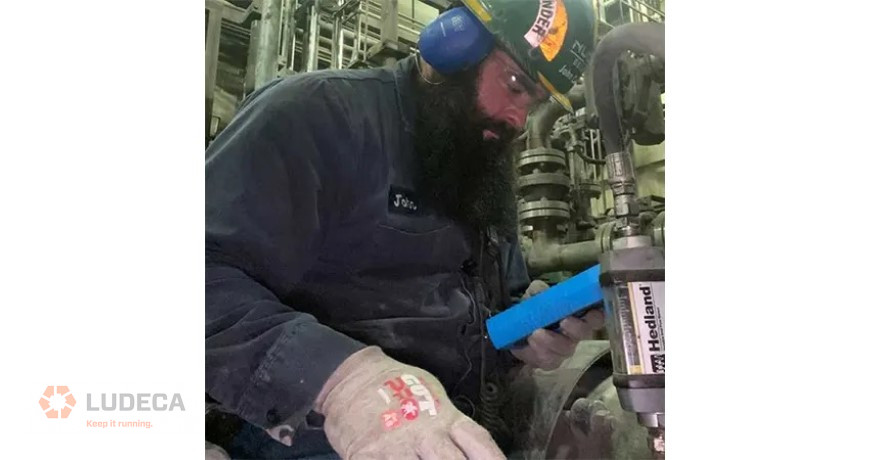
I would recommend this course to anyone interested in becoming more familiar with ultrasound regardless of current skill set. There is something to be learned for all levels of ultrasound inspectors. While some classes make you feel like a prisoner voluntold to be there, not here. It is fun, engaging, and flourished with a plethora of useful knowledge and information. In the short 8 weeks of this class, I have found several failing components in our mill. I’ve been able to prevent unplanned downtime multiple times by planning to change the components on our time rather than running them to failure.
Click here to continue reading the entire article, “Stories From the Melt Shop” to learn about John Garrison’s reliability journey and how ultrasound can help!
Thank you SDT Ultrasound Solutions for sharing this testimonial and case study with us!
by Diana Pereda
The ability to perform inspections on sealed enclosures in order to identify areas that could leak under pressure or vacuum is easily accomplished by utilizing ultrasound.
When a component’s tightness integrity deteriorates, one or two things can happen. Internal process fluids or gasses can leak into the environment, or contaminants can get into the process which can sometimes be catastrophic.
Examples of this include:
- Inspection sealed storage tanks.
- Seals for vehicle around the passenger compartment.
- Identification of leaks in welded and fabricated tanks.
- Inspection of waterproof enclosures for equipment or switchgear
- Shipping container and hatch inspections for the Marine cargo industry.
- Inspection of bulkhead seal areas on ships where electrical cables pass from
- One sealed compartment of a ship to sealed compartment.
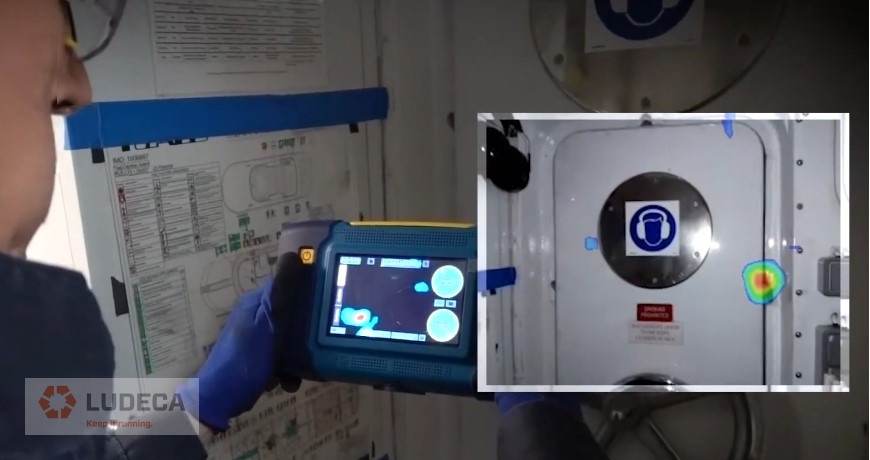
Watch our Tightness Testing with SonaVu Acoustic Imager video and learn how Ultrasound Imaging helps surveyors confirm the weather tightness of freight ships and eliminate spoiled cargo while ensuring the safety of crew members. Survey, detect and report leaks fast with our SonaVu™!
by Diana Pereda
Using the SDT flexible airborne sensor, sweep the coupling area listening for clicking, crackling, and/or popping sounds. The sound coming from a good coupling should be a low constant noise without any clicking or popping sounds.
The data shown below was taken from a flexible style coupling in good condition. Notice the low amplitude scaling (+30/-30 uV) on the left side of the data graph. Also, the waveform is relatively flat, indicating that no impacting is occurring.
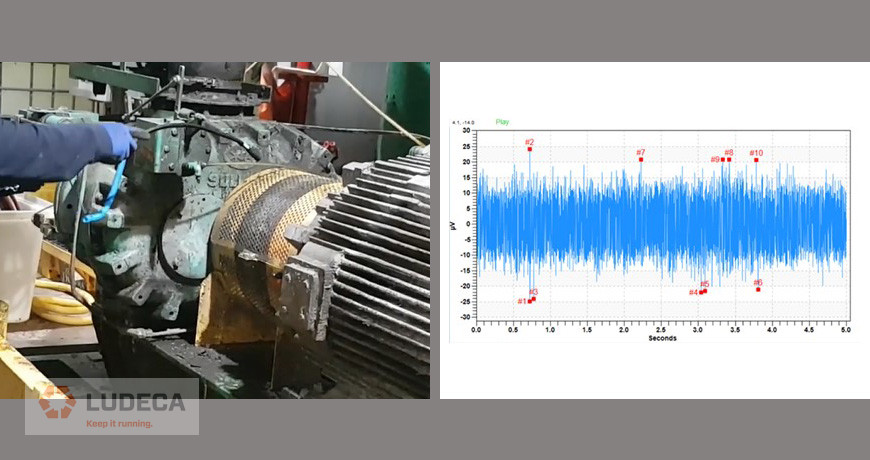
Contrast this with data shown below which was taken from a flexible grid-style coupling that lacked lubrication and as a result had caused damage to the coupling’s flexible grid.
Notice that the amplitude scale is now (+2000/-2000 uV) and impacting is apparent in the waveform data. In the spectrum, you can see an elevated turning speed peak with multiple harmonics indicating looseness and wear.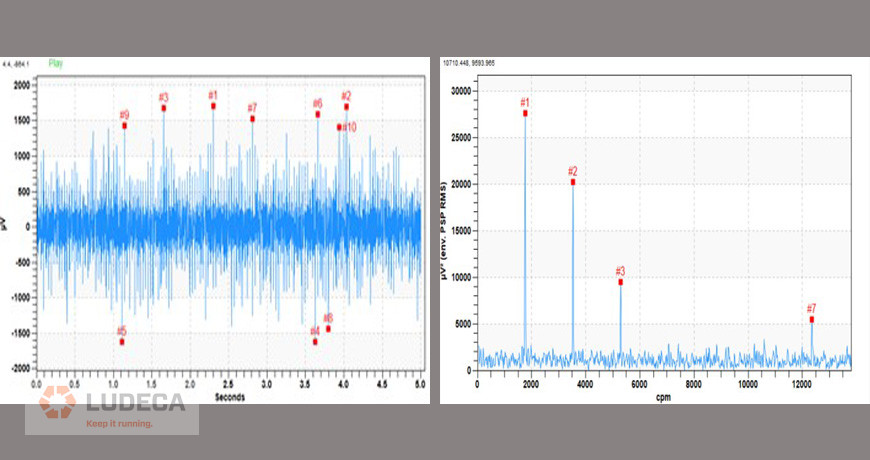
The images below show the condition of the flexible grid and the inside of the coupling housing after disassembly.
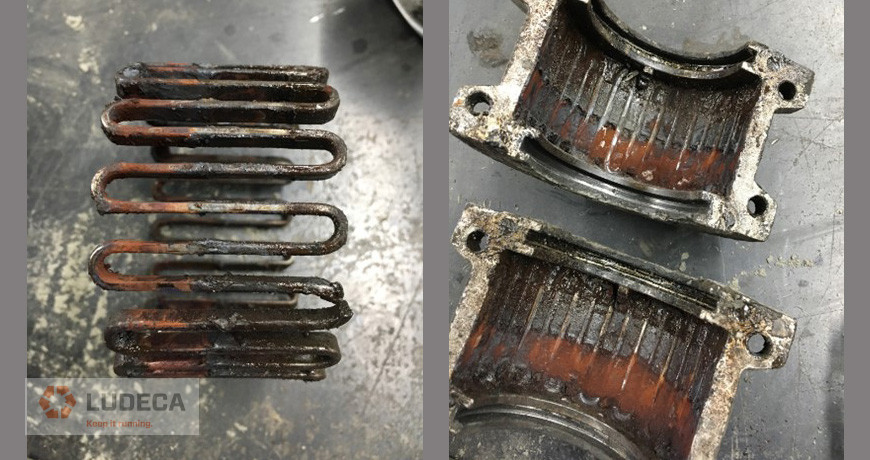
Download our Coupling Faults: Signs and Signals with Airborne Ultrasound infographic for a basic guide to coupling inspection using ultrasound technology.
Related Blog: Ultrasound and Alignment Meet at the Coupling to Reduce Failures
by Diana Pereda
Considering an Acoustic Imaging Camera? Read My Buying Tips First
Each year our condition monitoring world experiences innovation at some level, be it great or small. Even through a pandemic, leading tech companies continue to transform their solutions for the greater good of reliability. A recent example is the arrival of Acoustic Imaging Camera technology, also known as ultrasonic imagers.
Acoustic imaging cameras combine extremely sensitive multi-frequency sound sensors with digital imaging technology to provide ultrasound inspectors with a clear picture – or video – that illustrates precisely where an ultrasound source originates. By marrying our vision sense with our hearing sense, a more complete outcome is possible for certain airborne ultrasound inspections.

Now, mapping the origin of a sound to its source through imagery is an innovative breakthrough, but for someone who has followed the ultrasound market for more than thirty years, I am not surprised by these developments. Let us not forget history. Ultrasound has been with us for a long time. The notion that sounds existed outside the limited range of human hearing was first discovered in the late 1800s. Some 130 years on, Pierre Currie’s research with piezoelectrics remains as relevant today as it was when the first SONAR techniques provided ship captains with a solution for navigating deadly icebergs. Today, ultrasound offers improvements to our lives through medical, industrial, navigational, and cleaning applications.
Acoustic imaging technology is not particularly new. Sound mapping techniques have existed for a few years now, focused primarily on quality control applications. More recently, some clever manufacturers pushed forward with ways to utilize the technology for condition monitoring applications, primarily for energy waste reduction and electrical asset reliability.
Buyer Personas
When new technology first hits the market, predictable buying patterns emerge. Manufacturers love the early adopters; leading-edge consumers who are always first to own the latest and greatest gadgets the market has to offer. These mavens serve as a proving ground for new tech and often, their input helps steer the development for 2nd and 3rd product generations. Early adopters exist in sharp contrast to the “wait and see” crowd.
The wait-and-see crowd prefers to remain conservatively on the sidelines. They want assurance the technology will live up to its hype before opening their own wallets. If it proves to be a passing trend, they do not want to risk their money – and ego – buying something that might end up sitting on the shelf. If the technology does take hold they will still be waiting in line when the next release is ready, preferring that the early adopters do the testing for them. Eventually, when they do come aboard, their patience is rewarded by a product with most of the early problems ironed out.

For both the “early adopters” and “wait and see” users, buying tips from a trusted source helps relieve the stress associated with selecting their first ultrasound camera. After all, the investment is considerable and there may only be one chance to get it right. As someone who has lived his entire career inside the wonderful world of ultrasound, I am happy to share my insights about what you should look for in an acoustic imaging camera. This article identifies which features you should consider as “must-haves” and which ones are fluffy bits of window dressing, only there to distract buyers from less obvious deficiencies.
Buying Tip #1 – Do not buy a brand for the brand’s sake alone.

Innovations often come from the most unlikely origins, and when they do, they are honest and authentic; like the two Steve’s from Palo Alto who, in 1976, set out with a single goal to make computers personal and accessible to everyone. Had their mission been “to create the world’s first two trillion-dollar company” or “the world’s most iconic brand” they would not have succeeded beyond the confines of their parent’s garage.
Many of the ultrasonic imagers emerging today share similar humble beginnings. Born and nurtured by underfunded, tech-savvy start-ups, they eventually find their way to market by hitching themselves to well-established brands. Be mindful of this when shopping for your camera. The biggest brands may make the louder noise when it comes to trumpeting their marketing message; make sure the solutions they offer are equally capable of detecting the quietest noises in the loudest surroundings. At the end of the day, those are the ones you need to hear.
Buying Tip #2 – Take a peek behind the curtains.

When manufacturers develop new products, they know they must compete for the attention of the early adopters first. Some will dress up a product with features and functions that make it stand out but do not necessarily add top priority value. This approach can confuse buyers into choosing their camera based on fluffy features rather than performance. To avoid being duped, continually ask yourself why you want an ultrasonic imager in the first place. For my money, the emphasis should be placed on sensitivity and detectability. An acoustic imaging camera should be capable of detecting multiple types of defects in varying conditions. Do not allow yourself to be distracted by less relevant window-dressing features.
Buying Tip #3 – Buy an all-purpose camera.

Some acoustic imaging brands promote one camera model for finding compressed air leaks, and another for electrical assets. Really? Do we need two cameras to perform the same basic job? Steady now!
Using ultrasound to detect partial discharge in electrical assets and leaks in compressed air/vacuum systems has existed in tandem for five decades. The jobs were always performed perfectly using filtered sensors tuned in the range of 35-40kHz. This frequency choice has proven optimal for detection performance set against the contrast of loud, noisy, industrial factories. It takes into consideration the distance between source and sensor, the directionality of signal for fast pinpointing, and performance in environments characterized by elevated levels of audible background noise.
The laws of physics remain intact. The turbulent characteristics of these defects have not suddenly changed. They are as detectable today at 40kHz, as they were in the 1970s, 1980s, 1990s, 2000s, and beyond. There are no new technological discoveries or breakthroughs that warrant using a higher frequency for electrical discharges. In fact, higher frequency signals have shorter wavelengths, attenuate faster, and travel shorter distances, hampering their detectability over long expanses.
Click here to continue reading the entire article, “9 Buying Tips for Acoustic Imaging Cameras” by Allan Rienstra with SDT Ultrasound Solutions to learn about this exciting innovative technology.
by Diana Pereda

When it comes to condition-based monitoring, no matter how hard you try, you can never have 100% failure protection. At some point and on some level—even at the smallest levels—something is going to go wrong and your assets are going to fail. The best choice is to always plan for those sudden failures to minimize their damage in the end. The only way to ensure that is to have a very good detection strategy in place. Ultrasound helps greatly in achieving this milestone by helping you monitor the health of your entire facilities, giving you a much better proactive approach.
There are a lot of ultrasound devices that give you sound support for sensing high-frequency signals and understand their nature and characteristics. You can predict failures very easily, reduce energy costs because of unwanted downtime, and increase the productivity. But before, you go pick any random ultrasound device for your condition monitoring program, it is very important to know your goals and needs from that kind of program. You should involve every concerning department from planning and scheduling team to the technicians. They will provide you those small details and major insights to buy the right technology for your company.
The activities like inspection, leak detection, bearing condition monitoring, valve condition monitoring, and such take a lot of time. It is not possible to look for all the leak points and especially monitor every corner of your electrical and mechanical systems by relying only on visual inspection. This is where ultrasound saves a lot of time by monitoring change in friction and detecting any kind of turbulence way ahead of time to avoid any serious impacts on your machinery. This gives you enough time to plan for downtime and do maintenance in a scheduled way.
Any good ultrasound program always starts with a complete roadmap of your destination. You should always have an assessment strategy and planned goal alignment meeting in place. This also includes checking what kind of hardware and software will you need and what you have already in place. After you have bought an ultrasound device, make sure you check the facility and plan for on-site visits once in a while. Then you have to learn with time, document everything, have scorecards made, and start tracking the performance all the way. The results are not instant so there are some small wins and little ROI in the start but it gets better with time.
The major element that plays a huge is the cultural change here. You need to start recruiting skilled people, have experienced teams and consult other companies who have expertise in the ultrasound technology reliability-centered maintenance programs. They will guide you all the way if need be. Once you have knowledgeable people in your organization, make sure learning never stops because it makes the cultural change much easier with constant interaction among the staff. Once you have successfully implemented an ultrasound program and start reaping benefits from it, celebrate the victories.
Hear more from Allan Rienstra in this podcast by James Kovacevic to understand ultrasound and predict failures easily, reduce energy costs because of unwanted downtime, and increase the productivity.
by Diana Pereda

When it comes to condition-based monitoring, no matter how hard you try, you can never have 100% failure protection. At some point and on some level—even at the smallest levels—something is going to go wrong and your assets are going to fail. The best choice is to always plan for those sudden failures to minimize their damage in the end. The only way to ensure that is to have a very good detection strategy in place. Ultrasound helps greatly in achieving this milestone by helping you monitor the health of your entire facilities, giving you a much better proactive approach.
There are a lot of ultrasound devices that give you sound support for sensing high-frequency signals and understand their nature and characteristics. You can predict failures very easily, reduce energy costs because of unwanted downtime, and increase the productivity. But before, you go pick any random ultrasound device for your condition monitoring program, it is very important to know your goals and needs from that kind of program. You should involve every concerning department from planning and scheduling team to the technicians. They will provide you those small details and major insights to buy the right technology for your company.
The activities like inspection, leak detection, bearing condition monitoring, valve condition monitoring, and such take a lot of time. It is not possible to look for all the leak points and especially monitor every corner of your electrical and mechanical systems by relying only on visual inspection. This is where ultrasound saves a lot of time by monitoring change in friction and detecting any kind of turbulence way ahead of time to avoid any serious impacts on your machinery. This gives you enough time to plan for downtime and do maintenance in a scheduled way.
Any good ultrasound program always starts with a complete roadmap of your destination. You should always have an assessment strategy and planned goal alignment meeting in place. This also includes checking what kind of hardware and software will you need and what you have already in place. After you have bought an ultrasound device, make sure you check the facility and plan for on-site visits once in a while. Then you have to learn with time, document everything, have scorecards made, and start tracking the performance all the way. The results are not instant so there are some small wins and little ROI in the start but it gets better with time.
The major element that plays a huge is the cultural change here. You need to start recruiting skilled people, have experienced teams and consult other companies who have expertise in the ultrasound technology reliability-centered maintenance programs. They will guide you all the way if need be. Once you have knowledgeable people in your organization, make sure learning never stops because it makes the cultural change much easier with constant interaction among the staff. Once you have successfully implemented an ultrasound program and start reaping benefits from it, celebrate the victories.
Hear more from Allan Rienstra in this podcast by James Kovacevic to understand ultrasound and predict failures easily, reduce energy costs because of unwanted downtime, and increase the productivity.
by Diana Pereda
MAY 2020 – TRANSFORMER TECHNOLOGY

The term “Electrical Asset” casts a large net over an important class of systems. Whether it be substations, transmission and distribution lines, transformers, or motor circuit control cabinets, electrical assets play a key role in practically everything we do. Like most things we take them for granted until they fail to deliver their value. Then we scream.
Energy’s journey begins at the point of creation, can include storage, then transmission, distribution, and finally consumption. That journey is full of risk and the most significant risk contributor is partial discharge. Partial discharge happens when insulation material is compromised. One thing we know for certain is that once partial discharge begins, it will only get worse.
Partial discharge is more common than we would like to believe, even in new installations. Detecting these defects represents a serious challenge. Particularly at an early stage. There is no one perfect inspection technique, or technology, which can, on its own, detect and localize every defect, in every instance on every part of the electrical system.
Selecting the most appropriate method requires that the inspector understand the nature of the defect and the signs and signals available to be detected. The next logical step is to have the right technology available to pinpoint their location. Ultrasound is one technology that is mandatory for all electrical maintenance personnel. To not only reduce the risk of arc flash explosion but also enhance the overall reliability of system components.
When speaking about risk, health and safety should always take center stage. Safety aside, we must consider the risks from unreliable assets and loss of electrical equipment. They are both linked to downtime, costly legal exercises, and ultimately lost profit. Ultrasound is a solution that provides a reduced risk of all three in one go.

Ultrasound helps reduce the risk of arc flash exposure by detecting defects which, when left unattended, will lead to an arc flash event. I am not suggesting for one moment that we should not use PPE and other preventative measures. But I am yet to meet an arc flash suit which can detect an arc flash at its inception. So, the question is this: If an Arc Flash Suit is the last line of defense, then what is the first?
Some reliability minds seem obsessed with machines that rotate, while failure modes of non-rotating asset components seldom receive the routine surveillance they need. The pump and motor receive attention while the balance of the system is run-to-failure. Ultrasound testing could change this lackadaisical approach; especially considering its versatility, ease of use, and applicability to most hydraulic defects.
Click here to continue reading the entire article, “Ultrasound for Reliable Electrical Assets” by Allan Rienstra with SDT Ultrasound Solutions to learn about the common failure modes for electrical assets and how ultrasound can help.
by Diana Pereda
To resume our “The Rights of” blog post series which included The Rights of Precision Balancing and The Rights for Precision Shaft Alignment, I decided to give compressed air leak detection and repair a try with some basic rights when using PdM technologies like Airborne Ultrasound and Acoustic Imaging.

Here are my 14 rights to help you find those pesky and costly air leaks. Can you think of any others?
- Right safety procedures before you start your survey.
- Right leak management procedure to help you find-and-find leaks.
Download our Infographic Find-and-Fix Procedure to help environmental sustainability with reduced energy waste.
- Right pre-survey check of compressed air system layout/drawings.
- Right pre-survey gauge check (PSI)
- Right pre-survey inspection of pipe location, valves and fittings.
- Right leak detection instrument
Now days you can choose from an airborne ultrasound tool like our SDT ULTRAChecker all the way to an ultrasonic acoustic imaging camera like our new SDT Sonavu.
- Right leak location before you tag it.
- Right measured dBuV value in defect log.
- Right LOTO procedures before you start repair.
- Right leak location and severity report.
- Right leak elimination.
- Right re-measured dBuV value in work order.
- Right estimate of the cost impact of leaks.
- Right comprehensive reports to share your wins throughout your organization.

Download our SDT LEAKReporter App to help you document and quantify your energy savings $$$.
by Ana Maria Delgado, CRL
We previously discussed misaligned couplings and how to reduce failures when ultrasound and alignment meet in “Ultrasound and Alignment Meet at the Coupling to Reduce Failures.” In this follow-up blog, we will discuss how ultrasound and alignment come together to improve belt-driven performance.
Misalignment in belt-driven equipment is one of the leading causes of failures throughout the industry. It breaks down machines and often costs your company thousands upon thousands of dollars in repair expenses and unplanned downtime. Imagine if you could combine two technologies you may already be using to prevent some of these failures. Ultrasound and precision laser alignment will make your maintenance department ever more proactive than ever before.

Belts can be too loose, too tight, or be running on misaligned pulleys. Loose belts will slap and produce a noise similar to whiplash. Tight belts and misaligned belts will generate additional friction which will again be audible ultrasonically. Figure 1 is a sample time signal of slapping belts.
An easy way to detect and prevent failures is to add your belt driven machines to your ultrasound routes. It will require a few extra measurements on each route and some trending. However, the benefits will far outweigh the costs. By being able to tell when a belt system needs to be aligned and properly tensioned before it breaks down, we can be more proactive and less reactive.

Once the imminent failure is being detected, we can address it with a realignment of the belt drive unit using our Easy-Laser XT190 pulley alignment system. It is easy to use and it will provide the user with a PDF report for documentation and accountability.
This blog was inspired by Uptime Magazine’s article, “There’s Something in the Air”, July 2009, pp. 48-53, written by Thomas J Murphy with SDT Ultrasound Solutions.
Download our 5-Step Sheave Pulley Alignment Procedure which provides a simple and effective procedure for sheave pulley alignment of belt-driven equipment.
by Diana Pereda
Misalignment in rotating equipment is one of the leading causes of failures throughout the industry. It breaks down machines and often costs your company thousands upon thousands of dollars in repair expenses and unplanned downtime. Imagine if you could combine two technologies you may already be using to prevent some of these failures. Ultrasound testing and precision laser alignment will make your maintenance department more proactive than ever before. For example, we all know couplings can be misaligned, and couplings can be loose. Infrared training tells us that a misaligned coupling generates heat. This heat is generated by the periodic friction caused by the coupling being squeezed with each revolution. Remember, friction we can hear. Therefore, a misaligned coupling will generate a periodic ultrasound signal like the one shown in Figure 1.

If you are already using ultrasound and laser shaft alignment, you are already there. All you have to do is add the coupling data point to your current ultrasound routes. This simple step combined with some trending will tell you when you need to check and correct the misalignment on the pieces of equipment along the route. Furthermore, a loose coupling will generate an ultrasound signal caused by the fretting of the coupling halves rattling. This fretting will be harsher and less periodic in nature than misalignment (see Figure 2).

Once the imminent failure is being detected, we can address it with a realignment of the machines using an Easy-Laser laser alignment system like the XT770. It is easy to use and it will provide the user with a detailed PDF alignment report for documentation and accountability.
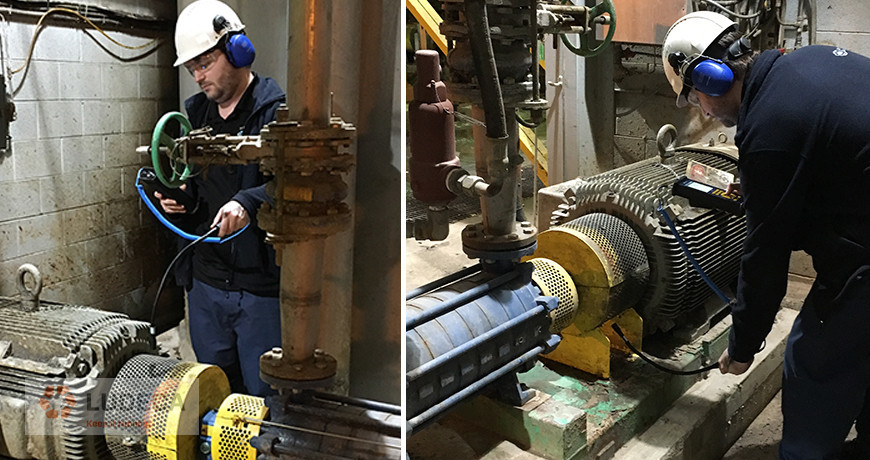
For more information on Ultrasound coupling, refer back to our blog, “Airborne Ultrasound Keeps Flexible Couplings Reliable” as shown above featuring our SDT340 Ultrasound Solution.
This blog was inspired by Uptime Magazine’s article, “There’s Something in the Air”, July 2009, pp. 48-53, written by Thomas J Murphy with SDT Ultrasound Solutions.
Download our 5-Step Shaft Alignment Procedure which provides a simple and effective procedure for shaft alignment of rotating equipment.
As an additional resource, we recommend watching, “Utilizing Ultrasound for Reliable Coupling” a presentation by Robert Dent with SDT Ultrasound Solutions
by Diana Pereda
Ultrasound for coupling inspection? What? Yes, ultrasound technology has many pillars for asset management. The technology is amazing and can be used in a variety of different not so obvious applications.

Types of couplings you can inspect with Ultrasound and how
There are many different types of couplings used in the industry for rotating equipment. These can range from short-flex, spacer type, to even Cardan shaft. Some require lubrication and others do not. One proven method to assess coupling conditions is to use an ultrasound analyzer with dynamic capabilities and a flexible airborne sensor and collect data for approximately 5 seconds per coupling. From there, a user can analyze the data using the Ultranalysis2 software to view the dynamic data (time waveform and spectrum).
Some machines may be running misaligned; therefore, the couplings may be loose. If we had a thermography camera, we could take an image of the heat signature which might show the periodic friction (squeezing of the coupling as it goes through each revolution). However, more often than not this will not be possible as all equipment must have coupling guards present during operation. Therefore, a flexible ultrasound sensor will be able to pick up that friction being generated by the coupling.
If you are currently not using an ultrasound system to check your couplings, it’s time to start!
Lack of lubrication and worn out grid coupling example:


Download our Coupling Faults: Signs and Signals Infographic.
by Diana Pereda
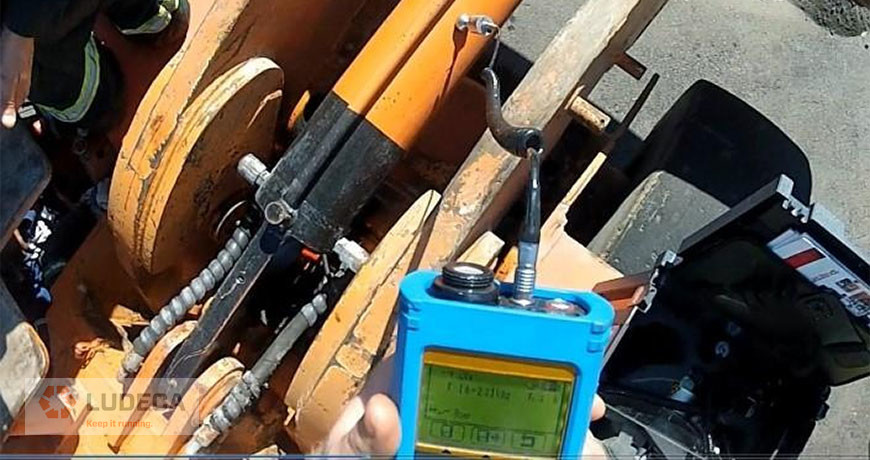
The many applications of Ultrasound, as diverse as they are, rarely get used to their fullest capacity. The Mining Industry poses many challenges in condition monitoring due to various machine types, speeds, and access.
Below are 10 of some of the prime applications for Ultrasound:
- Air Compressors and Blowers designed to supply air on demand often run inefficiently due to leaks. Use Ultrasound and SDT Leak Reporter to locate, document, and report leaks. Download our Leak Management: Find-and-Fix Leak Procedure for an effective procedure to survey your systems and detect leaks.
- Fugitive dust is an environmental problem and is often contained in the mining industry with the use of Baghouse Dust Collectors. The dust collectors require compressed air and diaphragms to purge the baghouse “socks.” A common failure mode for these socks is the ingress of moisture. One source of moisture ingress in compressed air lines are leaks. Another area to utilize ultrasound is for the diaphragms themselves. Use ultrasound to sweep across the diaphragm header to pinpoint a ruptured diaphragm. Typically these are only found after the differential psi indicates plugged bags and requires a physical inspection. Be proactive and efficient with ultrasound.
- Combustion Chambers in dryers that utilize natural gas are another area that can be prone to leaks. Check all the valves, and flanged connections periodically to identify a potential leak.
- Dryers and Kilns run at very slow speeds. Slow speed condition monitoring can be quite difficult using Vibration techniques. The slower the speed, the longer the sampling time and lower the amplitudes. Ultrasound can be utilized to quickly assess the bearing health and to ensure proper lubrication. Although the speed can be quite low, the frequencies of sound generated in rolling element bearings are ultrasonic due to friction of an inadequate lubrication film, or from the presence of subsurface asperities in the early bearing failure stages.
- High Voltage Electricity with potential for arc flash is used both above and below ground. Ultrasound can be used to safely locate arcing, tracking, and corona, without the need to open any panels. Use ultrasound underground on the 4160 V terminal connections, or on your miner Nips to ensure a good tight fit free of discharge. Scan the overhead electrical cables while driving down the conveyor lines and listen for electrical discharge.
- Mines are loaded with long Belt Conveyors both on the surface and underground. Ultrasound is great for monitoring the head pulleys, tail pulleys, take-up pulleys, and for noisy trough idler rollers and return rollers. We all know the havoc a seized idler can wreak on the belt and belt splices.
- The use of grid couplings is quite common on Fans and Crushers. Grid couplings require periodic lubrication and inspection for wear. This requires shutting down the equipment, performing lock out tag out, and disassembly. Use ultrasound and a flex wand to listen under and around the guard of a dryer for a loose fit coupling.
- Hydraulic Systems are used in many applications such as compactors, crushers, and booms on continuous miners. Use the contact RS2 probe to look for faulty psi relief valve and check valves.
- Mines typically have many designated Oxygen-Acetylene Bottle Storage areas. Acetylene is very unstable and can be quite explosive at atmospheric pressures. Use ultrasound to check for leaks and help lower the risk of an explosion.
- Hoists are used to bring ore up from underground. The bearings of the crown sheaves and drums can be quite difficult if not impossible to monitor with vibration analysis as the RPM of the equipment rarely stays constant long enough for good reading. With ultrasound, we need only about 15-20 revolutions for quality reading.
Today’s blog is inspired by a LinkedIn post written by our partners at SDT Ultrasound Solutions.
by Diana Pereda

Simon is a condition monitoring specialist from a local oil refinery. He contacted SDT for advice on predicting flexible coupling failures. Currently, they perform condition monitoring on their pumps and motors using vibration analysis. They identified most bearing failures in time but could not detect coupling defects; there was no safe place to mount a contact sensor. Several unexpected failures caused shaft damage and unplanned downtime.
Within the facility they identified 58 pump systems considered “A Critical”, meaning if they go down, the plant goes down. I suggested ultrasound as a fast, safe, and affordable coupling monitoring solution. The model I recommended not only provided Simon with a means to observe couplings, it also measures vibration, eliminating the need to carry two data collectors.
Vibration analysis performs poorly on flexible couplings for two reasons. First, there is no suitable contact point for an accelerometer. Second, the primary defect symptoms of a defective coupling are friction and impacting. These are best detected with ultrasound. An airborne sensor placed near the coupling quickly detects problems. If necessary, Simon can capture a dynamic measurement and trend the defect as it worsens. The SDT270DU gives Simon two choices. He can periodically check for defects (Good) or Simon can integrate all 58 couplings into his established bearing routes (Best).
I explained to Simon how several clients already trend couplings using the Flexible Wand. The SDT270 collects a STATIC ultrasound measurement that gives four indicators of the condition. The first two – Overall RMS and Max RMS – indicate the level of friction produced by the defect. When these indicators rise, maintenance may consider corrective alignment during a planned shutdown. The second two – Peak and Crest Factor – identify the emergence of impacting. Together, all four indicators establish a lifecycle trend for each coupling.
Once impacting appears, the Peak indicator increases in step with Overall RMS. Since Crest Factor (CF) is a ratio between RMS and Peak, a rising CF indicates that the window for simple maintenance has narrowed. At this stage, inspectors collect a DYNAMIC measurement. The DYNAMIC measurement gives a visual representation of friction and impacting severity using the time view. For both STATIC and DYNAMIC measurements, it’s important to define the signal acquisition time.
User-defined signal acquisition time, available exclusively on SDT instruments, is a luxury that lends ultrasound technicians the highest level of precision. Without the ability to set the sample time, inspectors must guess when to pull the measurement trigger, and then question the validity of their data. Simon explained that all 58 pumps turn at speeds above 1800 RPM. Accordingly, he should set his SDT270’s signal acquisition time to between one and three seconds. This guarantees data samples over 30-90 shaft revolutions.
Shaft couplings are guarded for safety and ultrasound inspectors working around rotating equipment must follow company safety policies. SDT designs safety considerations into their solutions. The Flexible Wand’s 10mm diameter sensor allows access to couplings without the need to remove safety guards. The 21” long sensor sports a comfortable, ergonomic grip that keeps the inspector’s hands at a safe distance.
Simon seemed convinced but wanted to #HearMore. Since this solution was already working well at a nearby paper mill, I introduced Simon to the plant manager, Sunil, and invited them both to lunch. Sunil and Simon connected on many common reliability issues that afternoon. He confirmed the affordability of this solution based on coupling failures alone but went on to explain how their mill was rolling out ultrasound for acoustic lubrication, steam trap monitoring, electrical inspection, and air leak management. Simon and Sunil continued their conversation well into the afternoon. They agreed that ultrasound, with its 8 application pillars for reliability, represented a fast, safe, and affordable technology with the potential to revolutionize reliability culture. I sat back, happily watching two passionate specialists strategize about reliability culture. I love my job.
Related Blog: Ultrasound for Coupling Inspection? Yes!
by Diana Pereda
- RMS – use it to indicate trends in friction levels (lubrication, stage 1&2 bearing failure)
- Max RMS – use it to indicate ultrasound signal stability (steam traps, chain drives, flexible couplings, linear bearings)
- PEAK – use it to indicate impacting (shift from stage 2 to stage 3 bearing failure, fatigue, gear mesh, broken gear teeth)
- Crest Factor – use it to correlate the relationship between friction and impacting on any asset (perfect for VFDs!!)
- Gas & Valve Leak – RMS
- Lubrication – RMS
- Steam Trap – RMS & Max RMS (+Peak for flash steam)
Impacting:
- Bearing, Gears – Peak & RMS (+Crest Factor)
Cavitation:
- Cavitation – Peak
Check out our SDT 200, 270, and 340 featuring the four condition indicators to detect, trend and analyze ultrasound and vibration.
by Diana Pereda

Compressed air is one of the three highest cost utilities in use at your plant. It is also one of the least maintained in terms of system leaks. Leaks are expensive and wasteful, but most often ignored. Leaks may occur anywhere in your compressed air system. Here’s our list of top ten most common leaks:
- Connections on air supply lines (pipes)
- Quick couplers
- Filters
- Pneumatic cylinders
- Pressure regulators
- Air dryers
- Isolation valves
- Control valves
- Automatic drain traps
- Air separators
Finding and fixing these leaks is an easy way to reduce energy costs, but finding them is not easy because of background noise. A good quality ultrasonic detector can hear turbulence despite the ambient noise of the factory floor.
Download our LEAK SURVEYORS HANDBOOK and learn how to reduce or eliminate wasted compressed air with ultrasound through effective leak detection and repair.
Source: Ultrasound Leak Surveyor’s Handbook by SDT International.
by Diana Pereda

